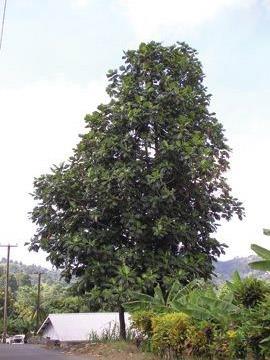Breadfruit - A Part of our Culture
The National Dish of St. Vincent and the Grenadines is Roast Breadfruit and Fried Jack Fish.
The month of August is declared “Breadfruit Month” by the government of St. Vincent and the Grenadines in order to highlight and promote the nation’s culture and heritage. In keeping with the St. Vincent and the Grenadines Association of Toronto’s intention to inform and educate our membership and readers of the Association’s newsletter, Insight, and visitors to the website a series of articles with pictures will be posted here.
The Education Committee of the Association will keep this page updated as it sees fit.
In their publication The Breadfruit Plant of St. Vincent and the Grenadines, First Edition, July 2004; a booklet produced by the Communications Unit of the St. Vincent and the Grenadines Ministry of Agriculture and Fisheries a number of recipes are available. Some of these will be posted on this site but we also invite our readers to submit their own recipes to us for sharing with others.
----------------------------------------------------
Breadfruit: From East to West – A Brief Account
by Fred Prescod
It is believed that the breadfruit is native to the Malayan Archipelago. From there it was carried to other Pacific islands in prehistoric times. There are later accounts of Spanish voyagers having come across the plant in the Solomon Islands during the 16th Century and in Tahiti in the early 17th Century.
At the beginning of the 18th Century English explorers promoted the idea of introducing the tree to the West Indies. Also, periods of famine during the late 1800’s prompted Jamaican plantation owners to petition King George III to import breadfruit trees to provide food for their slaves.
Now accounts of Captain William Bligh’s notorious 10-month voyage between 1787 and 1788 are well documented. His crew mutinied and set him adrift near Tahiti. In a second attempt Bligh sailed in 1791 with 2000 breadfruit plants bound for the West Indies. This voyage was successful. It resulted in the introduction of the breadfruit in 1793 to the islands of St. Vincent and Jamaica, from where plants were subsequently distributed to other islands of the West Indies.
Some authorities indicate that there is evidence of a French Navigator having brought a seeded variety of breadfruit to the French West Indies from the Philippines in 1772. It is also believed that some seedless and seeded breadfruit plants reached Jamaica from a French ship bound for Martinique but captured by the British in 1782. In addition there appears to be a record of a plant having been sent from Martinique to the St. Vincent Botanical Garden before 1793. It has also been suggested that the seeded breadfruit was carried by Spaniards from the Philippines to Mexico and Central America long before any reached the West Indies.
Today breadfruit trees are commonplace in the backyards and gardens of many rural and urban homes in the West Indies, and trees can be seen growing as far north as Key West, Florida. Raw or canned fruit can also be found in North American and European groceries and markets.
Of historical and horticultural significance is the presence today of a tree said to be a descendant of the original tree planted by Captain Bligh in the Botanical Garden in St. Vincent. And of course most Vincentians are aware of the fact that this Botanical Garden is the oldest in the Western Hemisphere. It was established in 1765.
----------------------------------------------------
A "National" Breadfruit Tree

[Photo by Reni King]
This breadfruit tree in the shape of the map of St. Vincent was photographed at Lower Hopewell in the Marriaqua valley. The photograph first appeared in the June 8, 2007 issue of the SEARCHLIGHT newspaper.
----------------------------------------------------
 View/Download 'Comparing Breadfruit, Breadnut, and Jackfruit: How are they Related?' (263KB)
View/Download 'Comparing Breadfruit, Breadnut, and Jackfruit: How are they Related?' (263KB)
 View/Download 'Breadfruit as Food & Medicine' (121KB)
View/Download 'Breadfruit as Food & Medicine' (121KB)
SVG Breadfruit Recipes
 View/Download 'SVGAT Breadfruit Recipes' (132KB)
View/Download 'SVGAT Breadfruit Recipes' (132KB)